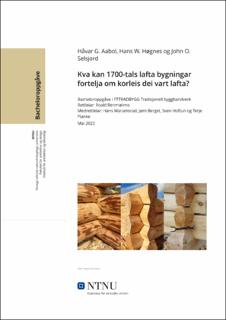| dc.contributor.advisor | Renmælmo, Roald | |
| dc.contributor.advisor | Marumsrud, Hans | |
| dc.contributor.advisor | Berget, Jørn | |
| dc.contributor.advisor | Hoftun, Sven | |
| dc.contributor.advisor | Planke, Terje | |
| dc.contributor.author | Aabol, Håvar G. | |
| dc.contributor.author | Høgnes, Hans W. | |
| dc.contributor.author | Selsjord, John O. | |
| dc.date.accessioned | 2022-07-16T17:21:00Z | |
| dc.date.available | 2022-07-16T17:21:00Z | |
| dc.date.issued | 2022 | |
| dc.identifier | no.ntnu:inspera:111366790:109213091 | |
| dc.identifier.uri | https://hdl.handle.net/11250/3006190 | |
| dc.description.abstract | Tema for denne oppgåva har vore om vi kunne lesa 1700-tals tømrahus, og måten dei er tømra på. Vi tre studentane som har skrive denne oppgåva, har teke for oss kvar vår bygning som har sitt opphav på 1700-talet. Desse bygningane er frå tre forskjellige regionar i Innlandet fylke. Regionane er Valdres, Hadeland og Nord- Gudbrandsdalen.
Tømringa i bygningane har vorte grundig studert, analysert og dokumentert. Vi har også studert fleire andre tømra bygningar frå 16-1700-talet, som har dei same trekka som referansebygningane, dette for å kunne få tak i så mykje informasjon om korleis arbeidsprosessen kan ha vore utført i sin tid. Dokumentasjonsarbeidet handlar også om verktøy til arbeidet. Det har vorte smidd kopiar av ei rekke forskjellige verktøy som til dømes økser og méder for å gjennomføre forsøket. Gjennom dokumentasjonsarbeidet har det oppstått forskjellige hypotesar, som til dømes korleis vart novskallen forma, halsing, nedhogg i ryggen av stokken, bruken av mé og maur, kor mykje stokkbearbeiding har det vore før stokken kjem opp i veggen, og det å tømre med ferskt tømmer og heng.
For å prøve ut hypotesane våre har vi valt å gjera kvar vår prøvetømring, der vi tømra nokre omfar kvar. Vi har ikkje tømra ferdig prøvekassane, men har tømra nok til at vi har fått god innsikt i korleis arbeidsprosessen kan ha gått føre seg, utan at det er noko endeleg svar men eit forslag.
Til slutt, som drøfting har vi satt opp, og prøvd å samanlikne metodane til kvarande. Sidan vi er tre handverkarar blir det naturleg tre måtar å tenke på, og tre måtar å gjere det på, som skil seg noko frå kvarandre. | |
| dc.description.abstract | The topic of this Bachelor thesis has been to figure out if we could read the way of construction in log houses from the 1700s. The three of us each investigated our chosen building, located in three separate regions of the district of Innlandet. The regions are Valdres, Hadeland and the northern part of Gudbrandsdal.
The style of log construction in the three logs houses has been thoroughly studied, analyzed and documented. To gather information for this project on how the construction process was executed during this era, several other similar log houses constructed during the 16- and 1700s were also studied. Tools used for the logging and carpenter job of building these houses has also been a part of the documentation. Duplicates of several different tools, for instance axes and log scriber (“méder”) was forged to execute this project. During the work of documenting for this project, several hypotheses occurred. For example, how was the hewing of the notchhead (“novskalle”) created, dimension of the end part of the log (“halsing”), hewing the lower notch (“nedhogg”) through the spine of the log, usage of log scribe (“mé” and “maur”), how much work on the logs has been done before the log was inserted into the wall, and how to log with fresh timber logs and overhang.
To test out the different hypotheses that occurred during this project we each crafted a few overlaps of logs. We did not finalize the test structure but crafted enough overlaps to get good insight into how the work process might have been, however noting that this is only a suggestion, not the final answer.
Finally, for the purpose of discussion we tried to compare the different crafting methods since we each have slightly different ways of crafting and thinking. | |
| dc.language | nno | |
| dc.publisher | NTNU | |
| dc.title | Kva kan 1700-talls lafta bygningar fortelja om korleis dei vart lafta? | |
| dc.type | Bachelor thesis | |
